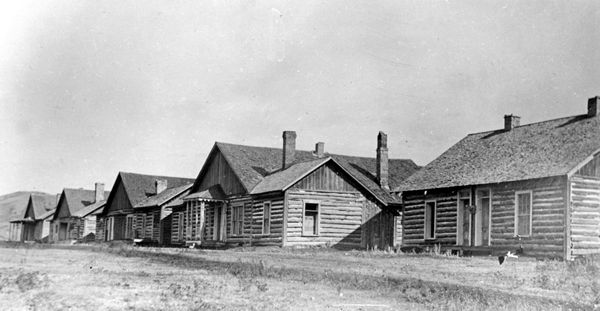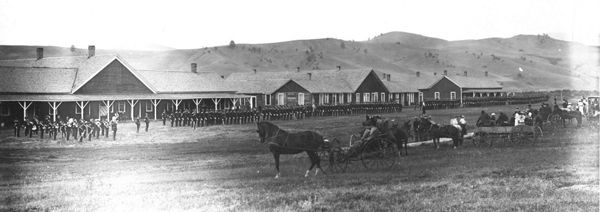
Echoes in the Valley: Fort Ellis and the Vanishing Legends of the American Frontier
The Gallatin Valley, nestled in the heart of Montana, is a landscape of breathtaking beauty and profound historical resonance. Majestic mountains, sculpted by ancient glaciers, cradle verdant plains where the Gallatin River braids its way towards the Missouri. Today, the bustling city of Bozeman thrives here, a gateway to Yellowstone National Park and a hub of outdoor adventure. Yet, beneath the veneer of modernity, the land holds countless stories – whispers of a bygone era when this valley was the very edge of the American frontier, a crucible where destinies clashed and legends were forged. Among these legends, often silent but ever-present, is that of Fort Ellis.
No sturdy palisades or barracks stand on the original site today, just a few historical markers on private land, easily overlooked by the casual passerby. The fort, once a vital military outpost, vanished with surprising swiftness after its decommissioning. But its physical absence only amplifies its legendary status. Fort Ellis is not merely a collection of historical facts; it is a potent symbol of westward expansion, a testament to the harsh realities of frontier life, and a quiet witness to the complex and often tragic collision of cultures that defined the American West. Its legends are not tales of ghosts or mythical beasts, but the enduring narratives of human ambition, resilience, conflict, and the indelible mark left upon the land.
A Sentinel on the Edge of Civilization

Established in August 1867, Fort Ellis was strategically positioned at the confluence of the Bozeman Trail and the road to the newly discovered Yellowstone goldfields. Its primary mission was clear: protect the flow of settlers, miners, and freight along these critical arteries, and provide a buffer against the indigenous tribes – primarily the Crow, Sioux, and Cheyenne – who viewed the increasing encroachment as a direct threat to their ancestral lands and way of life. The fort was named for Colonel Augustus Van Horne Ellis, a Union officer killed at the Battle of Gettysburg, a poignant reminder that the nation’s internal strife had barely subsided before the next great challenge, the conquest of the West, began in earnest.
Life at Fort Ellis was anything but glamorous. Far from the comforts of established civilization, soldiers endured brutal Montana winters, often isolated for months by deep snows. Summers brought their own challenges: intense heat, dust, and the constant threat of skirmishes. The fort housed companies of infantry and cavalry, their days filled with drilling, patrols, guard duty, and the backbreaking labor of maintaining the post. Supply lines were long and precarious, making self-sufficiency and resourcefulness paramount. "The frontier soldier’s life was a monotonous grind punctuated by moments of sheer terror," noted historian Robert M. Utley, a sentiment that perfectly captures the existence at Ellis. These men, many of them recent immigrants or those seeking an escape from post-Civil War America, were the physical embodiment of the nation’s westward drive, often caught between the abstract ideals of Manifest Destiny and the harsh realities of a hostile landscape and a determined indigenous population.
The Clash of Worlds: Defenders and Dispossessed
The true legends of Fort Ellis are inextricably linked to the collision of cultures it represented. For the white settlers, the fort was a beacon of safety, a symbol of progress and the promise of a new life. For the indigenous tribes, however, it was an unwelcome intrusion, a further erosion of their hunting grounds and sovereignty. The Gallatin Valley, particularly, was a contested territory, used by various tribes for hunting and travel. The Crow, generally more amenable to white presence due to their long-standing animosity with the Sioux, often acted as scouts for the army, adding another layer of complexity to the inter-tribal dynamics.
The Bozeman Trail, which Fort Ellis was established to protect, was a flashpoint of conflict. It cut directly through the prime buffalo hunting grounds of the Sioux and Cheyenne. While Fort Ellis itself saw fewer large-scale battles than some of its more infamous counterparts (like Fort Phil Kearny to the south), its soldiers were constantly engaged in patrols, pursuing raiders, and responding to attacks on settlers and freight wagons. Skirmishes were common, often resulting in casualties on both sides. These smaller, daily acts of bravery, sacrifice, and often brutality, though rarely making the grand historical narratives, formed the bedrock of the fort’s legend – the untold stories of individual soldiers, scouts, and Native warriors fighting for their lives and their beliefs.
One such legend involves the Yellowstone expeditions. Fort Ellis served as a crucial staging point for many early scientific and exploratory expeditions into the Yellowstone region. Perhaps the most famous was the 1871 Hayden Geological Survey, led by Ferdinand V. Hayden, which included artist Thomas Moran and photographer William Henry Jackson. Their work, protected by soldiers from Fort Ellis, provided compelling evidence of Yellowstone’s unique geysers and thermal features, ultimately leading to its designation as the world’s first national park in 1872. The courage of these explorers and their military escorts, venturing into an untamed wilderness, navigating both natural hazards and potential tribal encounters, speaks to a different kind of legend – one of scientific curiosity and human endeavor pushing the boundaries of the known world.
Whispers of Courage and Loss
The legends of Fort Ellis are also woven from the personal stories of its inhabitants. Consider the officers who served there: men like Colonel John Gibbon, who would later play a significant role at the Battle of the Little Bighorn, or Captain George L. Browning, whose death near the fort in 1867 at the hands of Sioux warriors underscored the ever-present danger. Browning, with a small detachment, was ambushed while attempting to retrieve stolen horses, a grim reminder of the high stakes involved in even routine operations. His grave, initially near the fort, served as a stark memorial to the human cost of expansion.

The fort also saw its share of drama and human interest beyond the battlefield. Families lived at Fort Ellis – officers’ wives, children, laundresses – bringing a semblance of domesticity to the harsh frontier. Their resilience in the face of isolation, disease, and danger is another facet of the fort’s legend. Imagine the women, far from their homes, raising children in a world where the nearest doctor might be weeks away, and the sounds of distant gunfire were a constant worry. Their stories, largely unrecorded, speak volumes about the strength and adaptability required to build a life on the edge of civilization.
For the indigenous people, Fort Ellis was a symbol of their diminishing world. Their legends, passed down through oral traditions, spoke of the spirits of the land, the wisdom of their ancestors, and the struggle to preserve their way of life against an overwhelming tide. While specific tales directly linking to Fort Ellis from Native perspectives are often difficult to unearth in written historical records, the broader narrative of resistance, negotiation, and forced relocation forms a profound and often tragic legend in itself. The very ground upon which the fort stood, once a hunting ground and thoroughfare for generations, became a place of confinement and confrontation.
The Vanishing Act: A Legacy Endures
By the mid-1880s, the strategic importance of Fort Ellis began to wane. The Northern Pacific Railroad had pushed through Montana, largely replacing the Bozeman Trail as the primary transportation route. The "Indian Wars" were drawing to a close, with most tribes confined to reservations. The need for a military outpost in the Gallatin Valley diminished significantly. In 1886, just 19 years after its establishment, Fort Ellis was officially abandoned.
Its dismantling was swift and thorough. The buildings, mostly constructed of timber, were sold off and moved, often repurposed for new structures in Bozeman and the surrounding area. Within a few years, little remained of the physical fort. The land reverted to agricultural use, and the traces of its military past were largely erased by plows and progress. This rapid disappearance is itself a legend – a testament to the fleeting nature of human endeavors against the vastness of the Montana landscape. Unlike stone castles that endure for centuries, the wooden forts of the American West were transient structures, built for a specific, often short-lived, purpose.
Yet, the legends of Fort Ellis persist. They are present in the historical records, in the archives of local museums, and in the collective memory of the region. They are in the names of local landmarks, in the pride of descendants of those who served there, and in the quiet contemplation of those who stand on the site today, imagining the sentries on watch, the bugle calls echoing through the valley, the sounds of horse hooves and distant gunfire.
The true legend of Fort Ellis is not found in a single heroic deed or a ghost story, but in its embodiment of a pivotal era in American history. It represents the audacity of westward expansion, the grit of the soldiers and settlers who braved the unknown, and the profound tragedy of the indigenous peoples who lost their lands and way of life. It reminds us that "legends" are often the sum of countless individual lives, sacrifices, and struggles that collectively weave the tapestry of a nation’s past.
Standing on the site of Fort Ellis today, surrounded by the majestic Gallatin Mountains, one can still feel the echoes of those legends. The wind whispers through the grasses, carrying the faint, imagined sounds of a bugle call, a distant hoofbeat, or a forgotten prayer. Fort Ellis, though gone from sight, remains a powerful and enduring legend of America – a silent, yet eloquent, sentinel guarding the stories of the frontier that shaped a continent and defined a nation. It is a place where the past feels remarkably close, reminding us that the foundations of our present were laid by those who lived, fought, and dreamed on the very edge of civilization.


